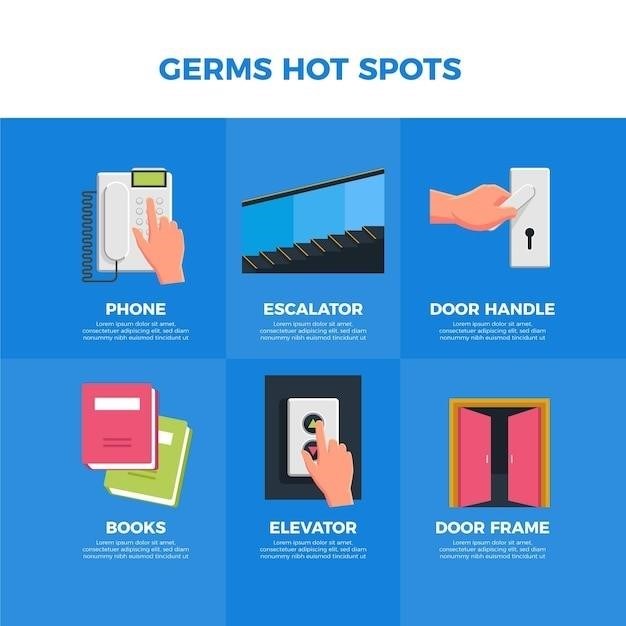Dometic Fridge⁚ A Comprehensive User Manual Guide
This guide provides comprehensive instructions for your Dometic refrigerator‚ covering safety‚ installation‚ operation‚ troubleshooting‚ cleaning‚ winterization‚ and disposal. Consult this manual for optimal performance and longevity of your appliance. Locate your specific model’s manual online for detailed specifications.
Understanding Your Dometic Fridge Model
Before beginning any operation‚ it’s crucial to identify your specific Dometic refrigerator model. This information is typically found on a label located inside the refrigerator compartment or on the exterior. The model number will help you locate the correct user manual and ensure you have the appropriate information for your appliance. Dometic offers a wide range of models‚ from compact units ideal for smaller RVs to larger refrigerators with advanced features. Knowing your model allows you to access specific details regarding features‚ controls‚ and troubleshooting procedures relevant to your unit. The model number is essential for obtaining parts‚ service‚ and warranty support. Carefully examine your refrigerator’s identification label to find this crucial information. This step is the foundation for safely and effectively using your Dometic refrigerator. Online resources like the Dometic website and manualslib.com offer additional support in identifying and understanding your specific model and its unique functionalities. This initial step will greatly enhance your understanding and usage of your Dometic appliance.
Safety Precautions and Warnings
Prior to installation and use‚ carefully review all safety instructions. Failure to comply with these warnings may result in serious injury‚ property damage‚ or even death. Never operate the refrigerator if you detect a gas leak; immediately evacuate the area and contact emergency services. Always ensure adequate ventilation to prevent the buildup of flammable gases. The refrigerator must be installed according to the manufacturer’s instructions to maintain stability and prevent accidents. Children should be supervised around the appliance to prevent injury or tampering. Do not store flammable materials near the refrigerator. Regularly check the power cord for damage and replace if necessary. If the refrigerator malfunctions and emits an ammonia smell‚ immediately switch off the power‚ leave the area‚ and contact qualified service personnel for repair. The use of this appliance requires adherence to all safety guidelines outlined in the accompanying documentation. Improper use may result in fire‚ explosion‚ or other hazards. Regular maintenance‚ as described in this manual‚ is crucial for safe and efficient operation. Always disconnect power before performing any maintenance or cleaning tasks. Regularly check the gas lines (if applicable) for leaks and ensure proper connections. Consult a qualified technician for any repairs or modifications to the appliance.

Installation Guide and Setup
Before beginning the installation‚ ensure you have all necessary tools and materials. Carefully read the provided installation instructions specific to your Dometic refrigerator model. Proper placement is crucial for efficient cooling and to prevent damage. The refrigerator should be installed in a well-ventilated area‚ away from direct sunlight and heat sources. Observe the recommended clearances specified in the manual to allow for adequate air circulation. Securely fasten the refrigerator to prevent movement during transit or operation. Connect the power cord to a suitable power outlet‚ ensuring the voltage matches the refrigerator’s specifications. If using LP gas‚ connect the gas line according to the instructions and check for leaks. Level the refrigerator to ensure proper door sealing and efficient operation. After installation‚ allow the refrigerator to cool down for several hours before loading food. Refer to the diagrams and illustrations in your manual for assistance with the installation process. If you encounter any difficulties during the installation‚ consult the troubleshooting section or contact Dometic customer support for assistance. Improper installation can void the warranty and compromise the safety and performance of the refrigerator. Always follow the manufacturer’s guidelines for optimal results.
Operating Instructions⁚ Basic Controls and Functions
Familiarize yourself with your Dometic refrigerator’s control panel. Locate the power switch‚ temperature controls (if applicable)‚ and any mode selection buttons. Turn on the refrigerator using the power switch. Adjust the temperature setting to your desired level. Most models offer various temperature settings‚ allowing you to customize the cooling intensity. Some models feature automatic temperature control‚ while others may require manual adjustment. Observe the indicator lights on the control panel to monitor the refrigerator’s operational status. Pay attention to any warning indicators that may appear‚ indicating potential issues such as high temperature or low gas levels. For models with multiple operating modes (e.g.‚ electric‚ gas‚ or auto)‚ select the appropriate mode based on your power source availability. Ensure the refrigerator door is properly sealed to maintain optimal cooling. Avoid frequently opening and closing the door‚ as this can lead to temperature fluctuations and increased energy consumption. Refer to the specific operating instructions for your Dometic model for detailed guidance on control functions and settings. Proper operation will ensure optimal food preservation and extend the lifespan of your refrigerator.
Advanced Features and Settings (if applicable)
Depending on your Dometic refrigerator model‚ you may have access to advanced features and settings to further optimize performance and convenience. Some models include programmable temperature settings allowing you to pre-set cooling levels for different times of day or usage scenarios. This could be particularly beneficial for conserving energy during periods of low usage or maintaining a specific temperature range for sensitive food items. Certain Dometic refrigerators offer various operational modes beyond basic electric and gas options‚ such as an “eco-mode” designed for reduced energy consumption‚ or a “vacation mode” that maintains a minimal cooling level while unoccupied. Explore the options for adjusting fan speed or compressor operation‚ if available. These adjustments could enhance cooling efficiency or reduce noise levels depending on your preferences and environmental conditions. Some higher-end models incorporate advanced diagnostic capabilities‚ displaying error codes to aid in troubleshooting. Consult your model’s specific manual for detailed instructions on using these features. Understanding and utilizing these advanced settings can enhance the efficiency and longevity of your Dometic refrigerator‚ providing a superior user experience. Always refer to your model’s user manual for precise instructions and safety precautions before implementing any advanced settings.
Troubleshooting Common Issues
If your Dometic refrigerator isn’t functioning correctly‚ this section provides guidance on resolving common problems. Begin by checking the power supply⁚ ensure the refrigerator is properly plugged in and that the circuit breaker hasn’t tripped. Verify that the gas supply is adequate if your model uses propane; check for leaks and ensure the gas valve is open. If the refrigerator is running but not cooling sufficiently‚ inspect the vents and ensure they are free from obstructions. Poor ventilation can significantly reduce cooling efficiency. Consider the ambient temperature; excessively high external temperatures can impact cooling performance. Examine the door seals for any damage or gaps; compromised seals can cause warm air to enter and reduce cooling effectiveness. For models with adjustable temperature controls‚ verify the setting is appropriate for the desired cooling level. Check for any unusual noises; loud humming or clicking sounds might indicate a mechanical problem requiring professional attention. Refer to your model’s specific troubleshooting section in the user manual for detailed guidance on addressing error codes or other specific issues. Remember that attempting complex repairs without proper training can cause further damage. If the problem persists despite following these steps‚ contact a qualified technician or Dometic service center for professional assistance. Safety is paramount; never attempt repairs involving gas lines or electrical components unless you possess the necessary expertise.
Cleaning and Maintenance Procedures
Regular cleaning and maintenance are essential for optimal performance and longevity of your Dometic refrigerator. Before cleaning‚ always disconnect the power supply to prevent electrical hazards. For interior cleaning‚ use a lukewarm‚ mild soapy solution and a soft cloth or sponge. Avoid abrasive cleaners or scouring pads‚ as these can scratch the surfaces. Thoroughly rinse with clean water and dry completely to prevent mold or mildew growth. Pay close attention to the door seals; gently clean any debris that may have accumulated in the grooves. Exterior cleaning is equally important; wipe down the exterior surfaces with a damp cloth to remove dust and fingerprints. Regularly inspect the condenser coils (located at the back or bottom of the unit)‚ removing any accumulated dust or debris with a vacuum cleaner brush attachment. This improves airflow and cooling efficiency. Check the drain pan (if applicable) for any water accumulation; empty and clean it as needed to prevent overflow or unpleasant odors. For models with ice makers‚ consult the user manual for specific cleaning instructions. Depending on your model‚ periodic defrosting might be necessary; refer to the manual for detailed procedures. Always refer to the manufacturer’s instructions for specific recommendations regarding cleaning solutions and maintenance schedules. Proper cleaning and maintenance will extend the life of your Dometic refrigerator and ensure optimal performance for years to come. Remember‚ preventative maintenance is key to avoiding costly repairs.
Winterizing Your Dometic Fridge
Proper winterization is crucial to protect your Dometic refrigerator from damage during periods of inactivity or freezing temperatures. Before beginning‚ always disconnect the power supply and turn off the gas supply (if applicable). Thoroughly clean the interior of the refrigerator‚ removing all food items and ensuring it’s completely dry. This prevents mold and mildew growth during storage. For models with ice makers‚ it is essential to follow the manufacturer’s specific instructions for winterizing the ice-making system to prevent damage from freezing. Depending on your climate and the severity of winter conditions‚ you may need to take additional steps to prevent freezing. One common method is to leave the refrigerator doors slightly ajar to allow for air circulation. This helps to prevent moisture buildup and the formation of ice. Alternatively‚ some Dometic models have a dedicated “airing position” described in the user manual. If your refrigerator is installed in a vehicle‚ consider using a cover or insulation to protect it from extreme temperatures and moisture. If your Dometic refrigerator is stored in a garage or shed‚ ensure the ambient temperature remains above freezing to avoid any damage from freezing. Before using the refrigerator again in the spring‚ inspect it carefully for any signs of damage or malfunction. Allow the refrigerator to reach its normal operating temperature before restocking it with food. Always consult your specific Dometic refrigerator’s user manual for detailed winterization instructions and recommendations. Following these guidelines ensures your refrigerator’s longevity and reliable operation year after year.
Disposal and Recycling Information
Responsible disposal of your Dometic refrigerator is essential for environmental protection. Before discarding your unit‚ always disconnect it from the power supply and any gas lines. Remove any remaining food items and thoroughly clean the interior to prevent odors and potential health hazards. Check your local waste management regulations for specific guidelines on appliance disposal. Many municipalities offer specialized programs for large appliances like refrigerators‚ often involving curbside pickup or designated drop-off locations. Some recycling centers accept refrigerators for component recycling‚ which diverts materials from landfills and reduces environmental impact. Inquire with your local recycling facility about their acceptance criteria and procedures for refrigerators. Before transporting your Dometic refrigerator for disposal or recycling‚ consider removing any easily detachable parts that may be recyclable separately‚ such as the door handles‚ shelves‚ and drawers. If you’re unsure about the proper disposal method‚ contact your local waste management authority or a qualified recycling facility for guidance. They can provide detailed information on acceptable disposal methods and any applicable fees. Remember that improper disposal of refrigerants can contribute to environmental damage. Therefore‚ it is crucial to follow the recommended procedures outlined by your local waste management authority or recycling center to ensure safe and responsible disposal. By adhering to these guidelines‚ you contribute to a cleaner and healthier environment.










